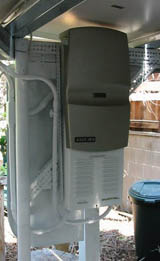|
The original installation had three 10-gauge conductors running from the unit in the back yard underground, through the garage, and then along the eves to the utility panel and electric meter on the northeast corner of the house. When I installed an electric oven in the kitchen, the easiest way for me to connect it to a 220 volt source was to tap in to the conduit where the three wires went to the utility panel fromthe Xantrex. Seemed an ok thing to do at the time. But then one day the fuse blew in one leg. As I later determined, this placed an unacceptable unbalanced load on the Xantrex, and it failed, frying the unit's solid-state output devices. Turns out, as I read in the NEW Xantrex's owner's manual, the neutral line is not a current-carrying conductor. It is there only to let the unit sense voltage. The main current output is between the out-of-phase legs at 220 VAC. So when the fuse blew at the utility panel, the electric oven's load appeared across one leg and neutral. As far as I can tell. The new Xantrex was $1.8k (ouch! It had barely paid for itself in power savings). But it is a much nicer machine. They've been hard at work redesigning their wares. It has no fan. Convection operating on by a nicely designed alminum heat sink cools the electronics. And no more fat huge DC wiring! It accepts up to 600 VDC, so the wires can be much smaller diameter. In the new installation, I used two series-strings of PV panels, each producing 340 VDC nominally. The two strings connect to the two parallel inputs in the Xantrex. The Old Xantrex Grid Inter-tie The image on the right shows the old Xantrex 2500 grid inter-tie unit that is no longer made. It required 48 VDC (nominal -- the unit's maximum power tracking algorithm determines actual operating voltage).The low voltage means the DC supply wires must be fat. There were half a dozen pairs of 10-AWG copper wires running into the thing.
The image on the right shows the old Xantrex 2500 grid inter-tie unit that is no longer made. It required 48 VDC (nominal -- the unit's maximum power tracking algorithm determines actual operating voltage).The low voltage means the DC supply wires must be fat. There were half a dozen pairs of 10-AWG copper wires running into the thing.
Its fan produces a quiet hum while it's churning out the kWs. Its simple readout told you how many Watt-hours it produced each day. Until it failed hard, it was very reliable. Once I thought it had failed. While troubleshooting, I noticed the grid voltage had climbed to 140 VAC on each leg (280 V total service). Ouch! The Xantrex had done its job and disconnected, preventing damage to its electronics. I called Southern California Edison and they repaired their regulator a mile down the road, returning the voltage to specification. When the Edison power went out of spec again the next year, this time sagging to 90 V per leg, I noticed the Xantrex had disconnected again, faithful to its specifications.
|